Amazon PPC (Pay-Per-Click) is Amazon’s advertising system, and it works exactly like it sounds: you only pay when a shopper clicks on your ad.
Think of it a rented eye-level shelf in the world’s biggest online store. Instead of waiting for customers to find your product on their own, you’re placing it directly in their path, right when they’re searching for it.
Why Amazon PPC Is Must for Sellers?
If you’re new to selling on Amazon, you cannot get initial sales and organic ranking without Amazon PPC. You might have a great product, but it’s stuck on page 10 of the search results where, let’s be honest, no one ever looks.
This is the problem Amazon PPC solves. It gives you a way to get instant sales and ranking and jump straight to the top of page one.
The whole system is an auction. Sellers place bids on keywords they want their ads to appear for. When a shopper’s search matches one of your keywords, your ad enters a real-time auction against other sellers. The winner’s ad gets displayed in a prime spot, like the top of the search results or on a competitor’s product page.
Let’s quickly break down how the PPC process works.
How the Amazon PPC Process Works
Amazon ads work on a simple flow: your product first gets impressions when shown to shoppers, then clicks if the ad looks appealing. A strong listing leads to add to cart, and finally a purchase. The more this cycle completes, the better your ads perform and the lower your costs become over time. Here are the details of how it goes,
1- You Bid: This is the maximum amount you’re willing to pay for a single click on your ad (e.g., “vitamin c serum”).

2- Amazon Bid Auction: A customer searches product with keyword “vitamin c serum” and Amazon instantly compares your bid and your product’s relevance against other advertisers and assigns a bid you will pay when your ad is clicked. See the bid auction process below.
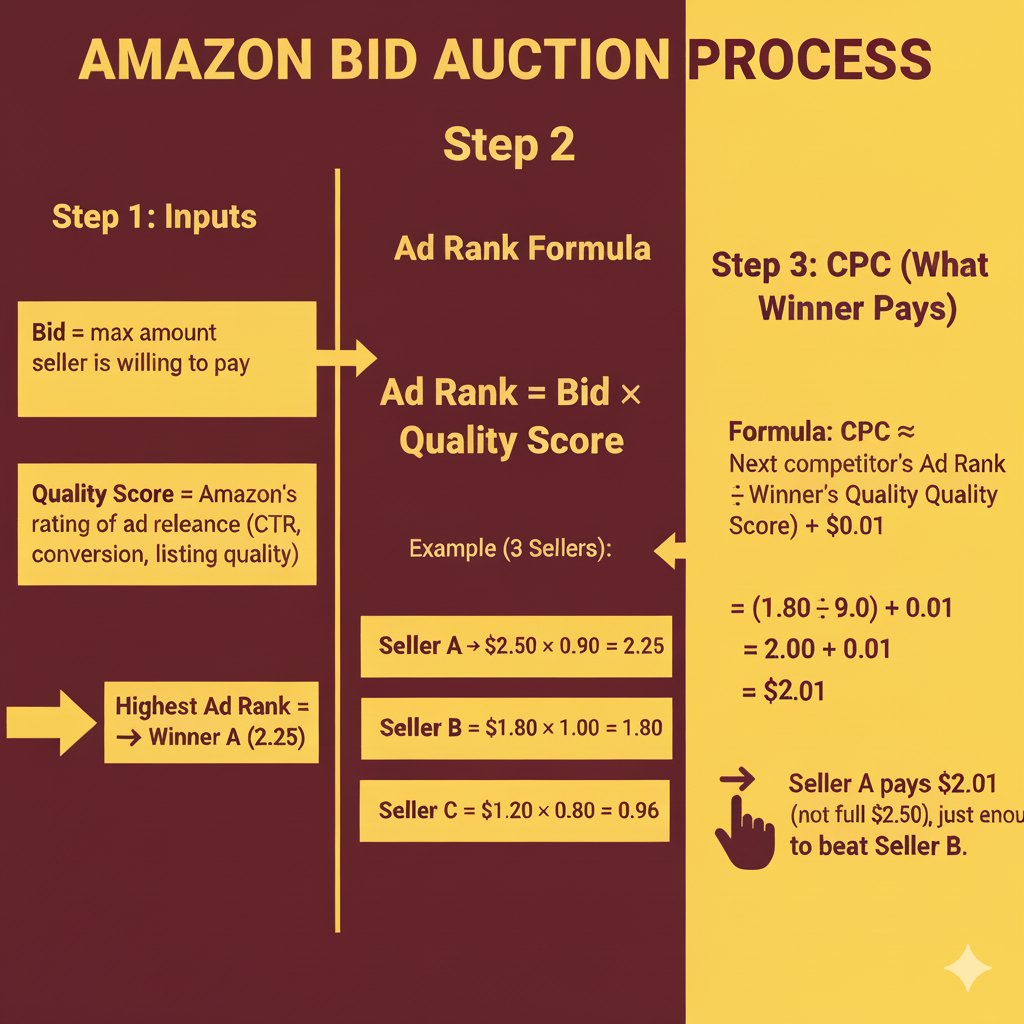
3- Your Ad Is Shown (Impression): If you win the auction, your ad appears in the search results. This is called an impression.

4- Shopper Clicks: The customer sees your ad and clicks it. You are now charged $2.01 for that click.
5- Shopper Buys (or Doesn’t): The customer lands on your product page and decides whether to make a purchase.
Why Do Sellers Rely on Amazon PPC So Much?
Sellers use PPC for a few critical reasons that go beyond just making a few extra sales.
- Launch New Products: When you have zero sales history or reviews, PPC is the fastest way to get your first customers. It kickstarts the sales flywheel.
- Drive Immediate Sales: Organic ranking is a long game that can take months. A well-structured PPC campaign can start generating traffic and sales within hours. This is a big part of learning how to improve Amazon sales effectively.
- Gather Customer Data: Your PPC reports show you the exact search terms shoppers use to find and buy your product. This is pure gold for optimizing your listing and marketing strategy.
- Defend Your Brand: Competitors will bid on your brand name to steal your customers. Running “defensive” campaigns on your own branded keywords protects your turf.
PPC advertising isn’t just an Amazon-specific trick; it’s a fundamental part of modern digital marketing. For those looking to scale operations, understanding the benefits of outsourced ecommerce success can be a game-changer, letting you focus on your brand while experts handle the complex logistics.
Key Amazon PPC Terms You Must Know
Before you spend a single dollar on Amazon ads, you need to speak the language of your advertising dashboard. These metrics are your report card. They tell you exactly what’s working, what’s a waste of money, and how shoppers are responding to your ads.
These acronyms can feel intimidating, but they are simple once you understand what they measure.
- Click-Through Rate (CTR): This shows how effective your ad is at getting a click. It’s the percentage of people who clicked your ad after seeing it. A low CTR is a huge red flag that your main image, title, or price isn’t compelling enough.
CTR = (Clicks ÷ Impressions) x 100
- Conversion Rate (CVR): The percentage of clicks that turn into a sale. A high CVR means your product page is doing its job. According to a recent Amazon advertising stats report, the average Amazon PPC conversion rate is around 10-12%, which is much higher than other e-commerce platforms.
CVR = (Total ÷ Total Clicks) x 100
- Advertising Cost of Sale (ACoS): This is the most talked-about metric in Amazon PPC. ACoS shows your ad spend as a percentage of the revenue those ads generated. A lower ACoS is almost always better.
ACoS = (Total Ad Spend ÷ Total Ad Sales) x 100
- Total Advertising Cost of Sale (TACoS): This metric gives you a bigger picture. It measures your ad spend against your total sales (both organic and ad-generated). It helps you see if your ad spend is helping your overall sales grow.
- Return on Ad Spend (ROAS): This is the flip side of ACoS. It shows you how many dollars in sales you get for every dollar you put into ads. A higher ROAS is what you’re aiming for.
ROAS = Total Ad Sales ÷ Total Ad Spend
Let’s make that real. If you spend $20 on ads and that generates $100 in ad sales, your ACoS is 20% and your ROAS is 5. That means you made $5 for every $1 you spent. Not bad.
Getting a handle on these terms is your first step. They are the foundation for making smart, data-driven decisions, like choosing the right keywords to target. If you’re starting from scratch, our guide on keyword research for Amazon will help you lay a strong foundation.
The 3 Main Amazon Ad Types
Amazon gives you a few different ways to get your products in front of shoppers. Picking the right one depends on your goal. Are you trying to get a quick sale, build brand awareness, or remind a shopper about an item they viewed?
Each ad type has a specific job. Let’s walk through the three main options.
1. Sponsored Products: The Workhorse for Sales
Sponsored Products are the foundation of Amazon advertising. For most sellers, this is where you start. These ads look just like organic search results, appearing in the shopping grid or on other product pages.
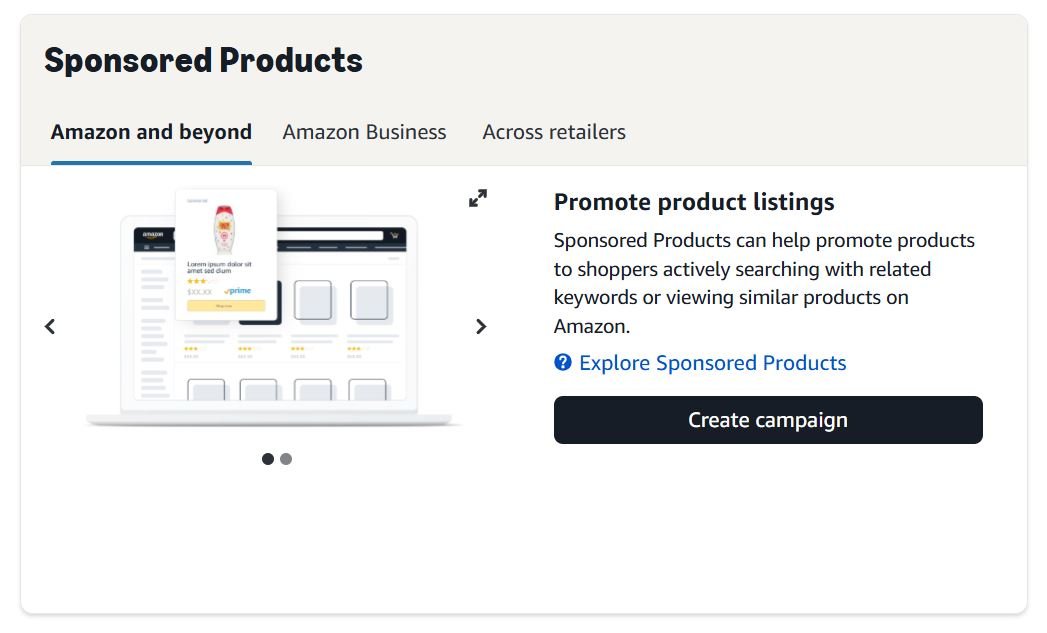
Their main purpose is simple: drive direct sales. Because they blend in so well, shoppers who are ready to buy click on them frequently. If you’re launching a product or want to give an existing one a sales lift, this is your starting point. A staggering 80%+ of all ad clicks on Amazon go to Sponsored Products.
You can learn more about building a strong foundation in our guide to Amazon Sponsored Products ads.
Sponsored Products Ads are the most frequently used, as they account for most of the sales and organic rankings, with nearly 70 to 80 percent of the budget allocated to these ads.
2. Sponsored Brands: For Building Brand Awareness
Next up are Sponsored Brands. Think of these as your brand’s billboard. These ads usually appear as a banner across the top of the search results, featuring your logo, a custom headline, and up to three of your products.
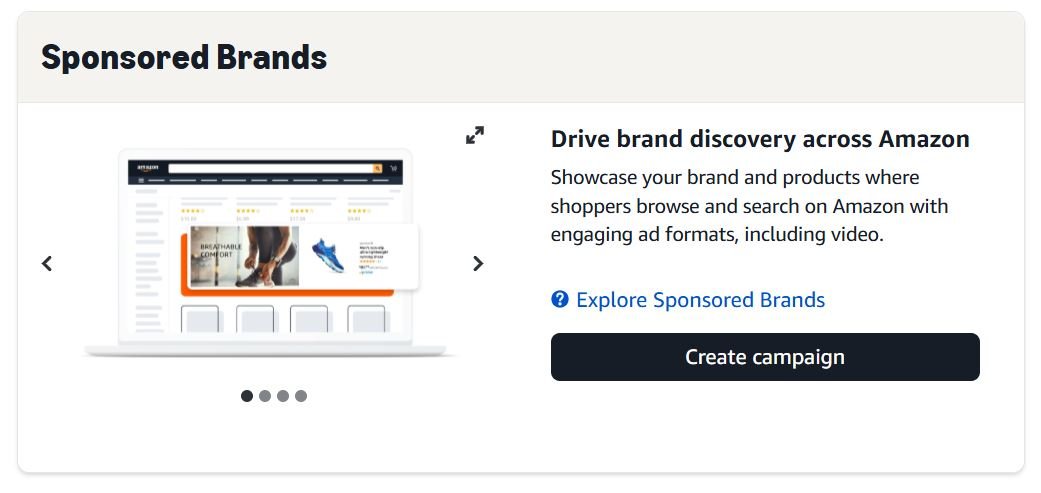
The power here is in brand discovery. When a shopper clicks your logo, you can send them to your Amazon Storefront to see your entire product catalog. You can also use Sponsored Brands Video ads, which are short, auto-playing videos that appear in search results and can really grab a shopper’s attention.
Use Sponsored Brands when: You want to build brand recognition, drive traffic to your Amazon Store, or showcase a collection of products together.
3. Sponsored Display: For Retargeting and Reach
Finally, we have Sponsored Display ads. These are your tool for reaching shoppers both on and off Amazon. Their primary function is retargeting. You can use them to show ads to shoppers who visited your product page but didn’t buy, reminding them of your product.
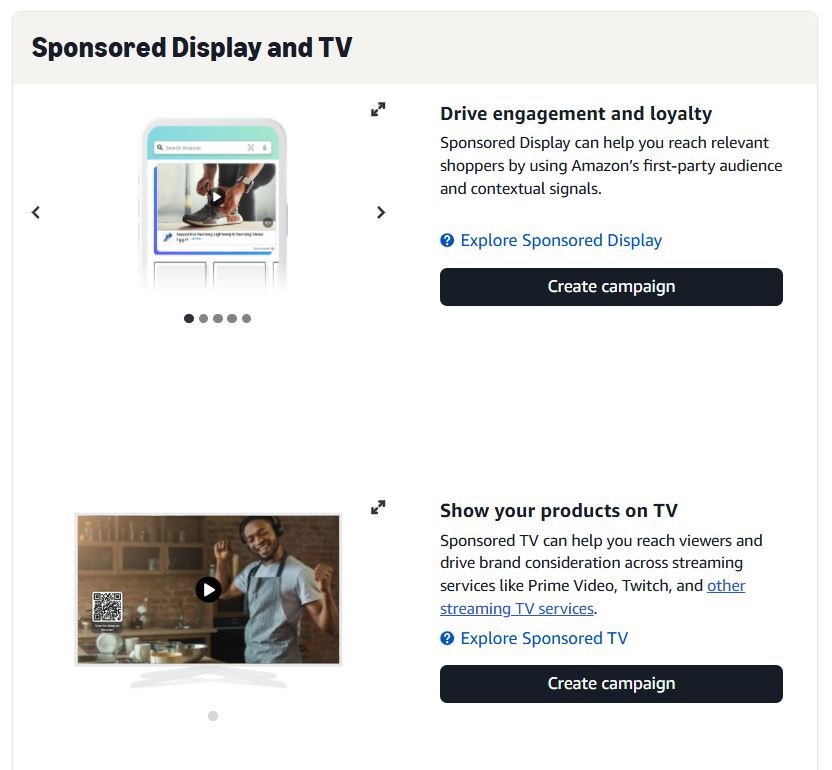
These ads can appear on a competitor’s product page, the Amazon homepage, or even on third-party websites and apps. It’s an effective way to stay top-of-mind and bring interested customers back to your listing.
Use Sponsored Display when: You want to retarget past visitors, cross-sell your products on competitor pages, or reach audiences beyond Amazon’s search results.
Your Guide to Sponsored Products Campaigns
Sponsored Products are the most commonly used ad type on Amazon and often the first step in any PPC strategy. Your initial campaigns aren’t just about driving early sales, they’re the foundation for collecting data, testing keywords, and understanding what convinces shoppers to move from a click to the “Add to Cart” button.
Let’s walk through building a solid Sponsored Products campaign from the ground up.
1. Automatic vs. Manual Campaigns
You’ll face a choice between two campaign types: Automatic and Manual. Most experienced sellers run both at the same time, as they work together.
1. Automatic Targeting: With automatic campaigns, you let Amazon handle targeting. You set your product, budget, and bid, and Amazon’s system decides where to show your ad based on shopper searches and related products. These campaigns act like a research tool, helping you discover keywords and placements that drive clicks and sales. Automatic campaigns has four match types and you have to target one match type per campaign not all together.

I. Close Match
Your ad shows when shoppers search with terms closely related to your product.
Example: A “wireless mouse” ad appears when someone searches “Bluetooth mouse.”
II. Loose Match
Your ad appears for broader or less direct searches.
Example: That same “wireless mouse” ad shows up when someone searches “computer accessories.”
III. Substitutes
Amazon places your ad on product detail pages of items similar to yours.
Example: Your “wireless mouse” ad appears on a Logitech mouse’s detail page.
IV. Complements
Your ad is shown on pages of products that pair well with yours.
Example: Your “wireless mouse” ad appears on a laptop or keyboard product page.
2. Manual Campaigns
Unlike automatic campaigns, manual campaigns give you full control over where your ads appear. You decide which keywords or products to target, set your own bids, and guide Amazon’s algorithm instead of leaving everything on autopilot. This makes manual campaigns ideal once you’ve gathered data from automatic campaigns and want to focus on what works best.

I. Keyword Targeting: Here you tell Amazon which search terms you want your ad to show for. You can choose different match types — exact, phrase, and broad (explained in coming section), to control how closely the shopper’s search must match your keyword.
Example: If you target “wireless mouse” as a keyword, your ad may show when a shopper searches that exact phrase, or in broader variations depending on the match type you select.

II. Product Targeting: Instead of targeting keywords, you can place your ads directly on specific products or products in a category. This is powerful for showing your ad next to competitors or complementary items.
Example: If you sell a “wireless mouse,” you can target detail pages of Logitech or HP mice (competitors), or laptops and keyboards (complements).

A classic strategy is to launch an automatic campaign first to “harvest” profitable search terms. Once a term proves it drives sales, you move it into a manual campaign where you can bid more confidently.
2. Keyword Match Types (Broad, Phrase, Exact)
In your manual campaigns, you tell Amazon how closely a shopper’s search should match your keyword. There are three options.
Let’s say we’re selling a “silicone baking mat.”
| Match Type | Example Keyword | What Shopper Searches Could Trigger Your Ad |
|---|---|---|
| Broad | silicone baking mat | “oven safe mat,” “non stick silicone sheet,” “large baking mat” |
| Phrase | silicone baking mat | “large silicone baking mat,” “silicone baking mat set,” “red silicone baking mat” |
| Exact | silicone baking mat | “silicone baking mat,” “silicon baking mat” (and very close variations) |
Broad Match gives Amazon the most freedom. Phrase Match is stricter, requiring the search to contain your keyword phrase in the correct order. Exact Match gives you the tightest control.
3. Placement Settings
Amazon enables you to raise your bid at specific locations on the platform and assign a percentage for each placement. The three types of placements are detailed below.
1- Top of Search (First Page): This term describes the prominent position at the start of search results. This location is highly desired due to its superior conversion rate, leading to consistently high bidding activity for this spot.
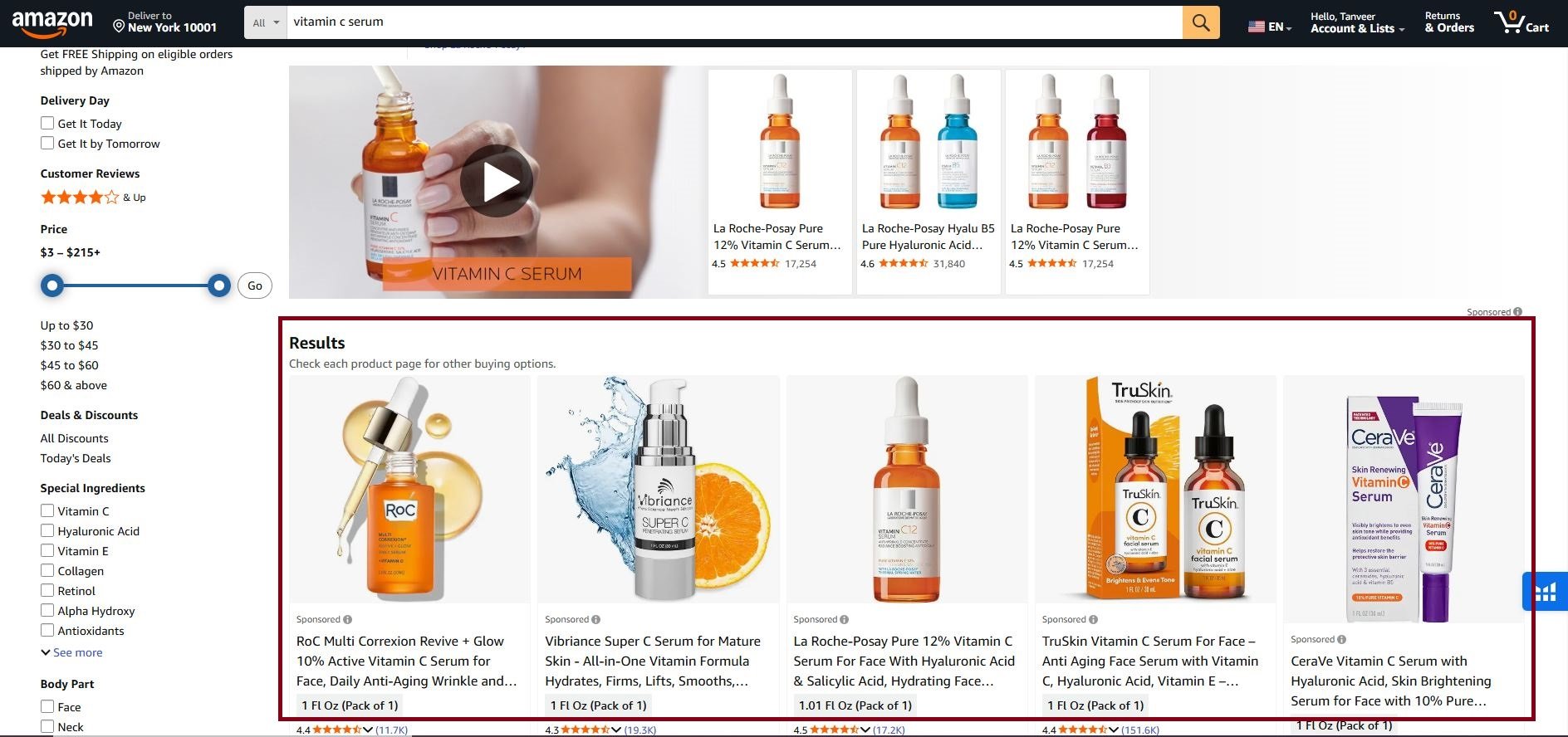
2- Product pages: This includes the detail pages of your competitors’ products or those that are complementary, offering opportunities for strategic placement.

3- Rest of search: This encompasses all other positions within the search results beyond the first page. Here, you have the option to raise your bid by a certain percentage, up to 900%, for placements that demonstrate strong performance for your objectives.
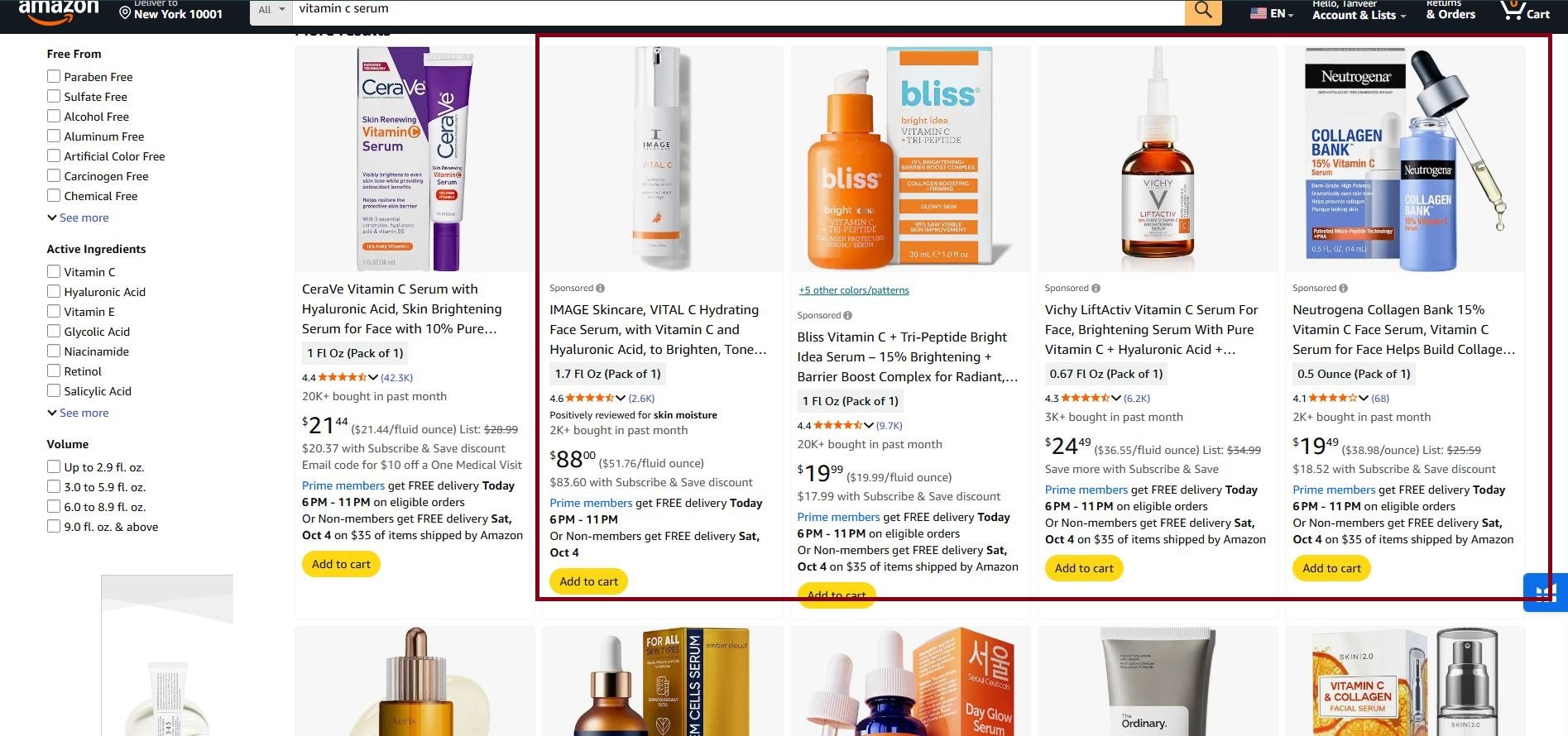
Let’s understand the placements with an example. If you set a bid of $2.50 for an Amazon ad and you apply a 30% increase for the “top of search” placement, the adjusted bid for this specific placement would be calculated by increasing the base bid by 30%.
Here’s how it works:
- Original Bid: $2.50
- Increase for Top of Search: 30% of $2.50 = $0.75
So, the adjusted bid for the “top of search” placement would be:
- Adjusted Bid: $2.50 + $0.75 = $3.25
Therefore, for top of search placements, your bid would be $3.25.

4. Bidding Strategies and Placement Adjustments
When setting up a Sponsored Products campaign, Amazon gives you the option to choose one bidding strategy during campaign creation. There are three strategies available, and the one you pick determines how your base bid will behave in the ad auction.

- Dynamic bids – down only
Amazon may lower your bid if a click seems less likely to convert. It never increases your bid above the amount you set. - Dynamic bids – up and down
Amazon can raise or lower your bid in real time depending on the likelihood of a sale. For example, bids may increase by up to 100% when the placement is more likely to convert, and decrease when conversion is unlikely. - Fixed bids
Amazon uses exactly the amount you set, with no real-time adjustment up or down.
Previously we discussed that your bid can change depending on the placement (where the ad shows, like top of search or product detail pages). On top of that, your chosen bidding strategy also affects how much you actually pay. Let’s look at both together in simple example
- Dynamic Bids — Up and Down
Amazon raises or lowers your bid in real time based on how likely the shopper is to buy.
Top of search: Amazon can raise your $2.50 bid by up to 100% → up to $5.00. If you also set a 30% placement increase, that $5.00 can climb to $6.50.
Rest of search: Amazon can raise by up to 50% → $2.50 can rise to $3.75. With a 30% placement increase, it could reach around $4.87.
Product detail pages: same as rest of search → $2.50 can rise to $3.75. With 30% placement increase → about $4.87.
- Dynamic Bids — Down Only
Amazon only reduces your bid if conversion chances look low. It won’t increase your bid automatically.
Top of search: stays at $2.50, unless you manually set a placement increase. With a 30% increase, it becomes $3.25.
Rest of search: can drop below $2.50. If you keep the 30% placement increase, your starting bid before reductions is $3.25.
Product detail pages: same as rest of search.
- Fixed Bids
Amazon always uses the exact bid you set. It doesn’t raise or lower it — but placement adjustments still apply.
Top of search: always $2.50, or $3.25 if you apply a 30% placement increase.
Rest of search: always $2.50, or $3.25 with the 30% placement increase.
Product detail pages: always $2.50, or $3.25 with the 30% placement increase.
Selecting an appropriate bidding strategy is crucial. For the majority of campaigns, it is advisable to use either ‘Dynamic Bids — Down’ or ‘Fixed Bids’ Only. However, if you have a substantial budget and aim to secure top positions aggressively, opting for ‘Dynamic Bids — Up and Down’ may be suitable, as these options tend to involve higher expenditures, as seen in the doubling of bids.
5. What is a Good Campaign Structure?
A well-organized Amazon PPC campaign structure is key for efficient management. It enables accurate performance tracking, effective budget allocation, and campaign optimization. Simplifying keyword and product identification, it improves ROI and targeting, controls spending, and boosts conversion rates. Here is best Amazon PPC campaign structure for best performance
- One Ad Group: One campign with one ad group.
- 5-10 Keywords: 5 to 10 maximum keywords for best performance
- One Match Type: Dedicate each each campaign to a single match type (e.g., a camaign for Broad match, another for Phrase match).
This keeps things organized and makes it easy to see which keywords and match types are performing best. For a deeper dive, check out our guide on Amazon PPC campaign structure.
6. Negative Keywords
Negative Keywords play a crucial role in reducing unnecessary ad expenses by indicating to Amazon the search terms for which you do not want your ad to appear. For instance, if your product is a premium “glass water bottle,” you might add “plastic” and “cheap” as negative keywords.
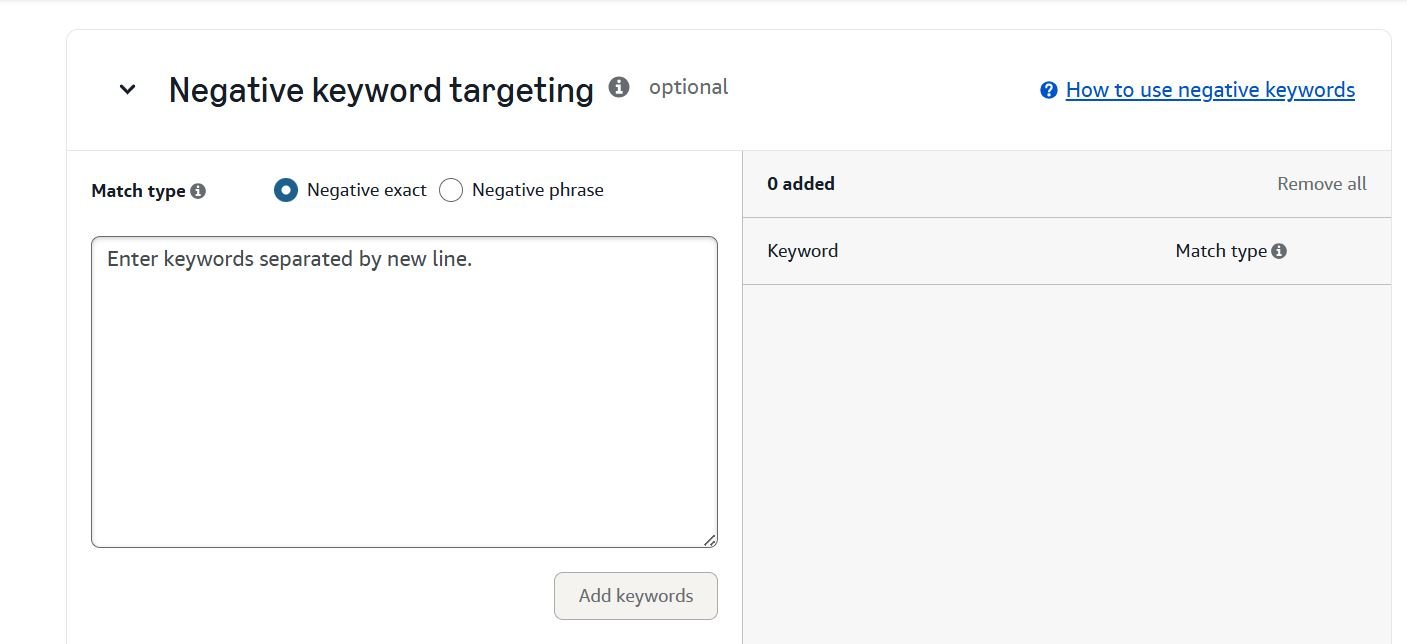
In negative targeting, there are two additional options: “Negative Exact” and “Negative Phrase.”
- Negative Exact prevents your ad from appearing when a user searches for the exact term you specify. For example, if “plastic water bottle” is set as a Negative Exact, the ad will not show when someone searches for precisely that term.
- Negative Phrase ensures your ad does not appear if the specified phrase is part of a search query. For example, if “cheap bottle” is set as a Negative Phrase, any search containing this phrase, such as “cheap bottle deals,” will not trigger your ad.
7. How to Create a Sponsored Products Campaign (Step-by-Step)
Step 1 – Log into Seller Central and navigate to the Advertising Console.

Step 2- Click “Create campaign” and choose Sponsored Products.

Step 3: Select the products you want to advertise.

Step 4: Choose your Targeting (Automatic or Manual) and select the bid amount. If Manual, select Keyword Targeting and enter your 5-10 keywords with their match types and bids.

Step 5: Select your Bidding Strategy. We recommend starting with Dynamic Bids – Down Only.

Step 6: Entre bid adjustment percentage to increase your bid for specific Amazon placements.

Step 7: Give your campaign a clear Name, Start & End date (e.g., “Product X – Auto Campaign”) and set a Daily Budget (a starter budget of $20-$30/day is a safe place to begin).

Step 8: Hit “Launch campaign” and you’re live.
Guide to Sponsored Brands
Sponsored Brands ads help you showcase your brand and products at the very top of Amazon search results, within search results and product pages. These ads usually include your video or selection of products. Shoppers who click can either go to your Amazon Store or directly to a product detail page.

There are two main formats:
Product Collection Ads – Show multiple products with your banner/video, logo and headline. Best for driving traffic to your Store or highlighting a group of items.

Video Ads in Search Results/Product Pages – Play automatically in search results and on product pages. You can link them to a single product page or your Store. Short, engaging videos work best to grab shopper attention.

Guide to Sponsored Display Ads
Sponsored Display is Amazon’s audience-based ad type. Unlike Sponsored Products or Sponsored Brands, which mainly appear in search results, Sponsored Display lets you reach shoppers both on and off Amazon. These ads can appear on product detail pages, customer review pages, the Amazon homepage, and even third-party websites or apps through Amazon’s display network.

Key Formats
Product Detail Page Ads – Show up right on competitor or complementary product pages. For example, if you sell protein powder, your ad could appear on the detail page of a competing supplement.
Audience Ads (On and Off Amazon) – Reach shoppers who viewed your product or similar items but didn’t purchase. These ads can follow them across Amazon and partner sites, reminding them to come back and buy.
Above the Fold / Homepage Placements – Sponsored Display can also appear in premium spots like the Amazon homepage or “buying guide” sections.
Targeting Options
Product Targeting – Choose specific products or categories where your ad should appear. This works well for showing up against competitors or alongside complementary items.
Audience Targeting – Target shoppers based on behavior, such as:
Views Remarketing – People who visited your product but didn’t buy.
Purchases Remarketing – People who bought from your category or your brand in the past.
Amazon Audiences – Prebuilt audience groups (e.g., “Pet owners” or “Fitness enthusiasts”) based on Amazon’s shopping data.
Using Amazon PPC Reports
Most sellers rely only on campaign dashboards and overlook the detailed data available in Amazon’s downloadable PPC reports. These reports show how ads actually perform across placements, keywords, and products, making them essential for real optimization.
1. Where to Find PPC Reports
You can access these reports from Amazon Seller Central or the Amazon Advertising Console:
- Go to Advertising in the top menu.
- Select Campaign Manager.
- Click Reports in the left sidebar.
- Choose the report type, date range, and file format (CSV or Excel).
- Click Create Report, then download it once it’s ready.
You can analyze these files directly in Excel, Google Sheets, or through a PPC management tool.
2. Main Amazon PPC Reports
Each report provides different insights for campaign improvement:
- Search Term Report: Lists every shopper search query that triggered your ad, with clicks, spend, and sales data.
- Keyword Report: Shows performance by keyword, including CTR, conversion rate, CPC, and ACoS.
- Placement Report: Breaks down how ads perform in each placement (top of search, product pages, rest of search).
- Campaign Report: Summarizes impressions, clicks, ad spend, and ACoS for all campaigns.
- Advertised Product Report: Displays ad performance by ASIN to see which products convert best.
- Purchased Product Report: Identifies which ASINs were actually bought after a click—useful for spotting cross-sell opportunities.
- Performance Over Time Report: Helps you track metrics day by day or week by week to catch seasonal or trend-based changes.
3. How to Use the Search Term Report
The Search Term Report is the most valuable file for practical Amazon PPC management. Experienced sellers use it every week to refine keyword targeting, reduce wasted spend, and improve ACoS.
Here’s how to make it useful:
Focus on real conversions. Sort by orders or sales to find search terms that drive results. Move these into manual targeting campaigns with exact match for tighter control.
Cut wasted spend. Filter for high-spend, zero-sale queries and add them as negative keywords. This is the fastest way to improve profitability.
Uncover long-tail keywords. Look for low-impression but high-conversion search terms. These often have lower cost per click and stronger buyer intent.
Compare match types. See how broad, phrase, and exact match campaigns perform. Shift bids based on which gives the best return on ad spend (ROAS).
Link PPC data with SEO. Add top-performing search terms into your product title or bullets to boost organic ranking.
Checking this report weekly keeps your Amazon PPC campaigns efficient, ensures smarter bid optimization, and helps connect your ads with actual shopper intent.
Amazon PPC Bulk Operations
For sellers managing multiple campaigns, Bulk Operations in Amazon Advertising is the fastest way to make large-scale changes and analyze performance without opening each campaign manually. The Bulk File lets you edit bids, keywords, budgets, and campaign settings directly in Excel or Google Sheets, saving hours of work.

- Go to Amazon Advertising Console or Seller Central.
- Click Campaign Manager from the Advertising menu.
- Select Bulk Operations from the left sidebar unde “Sponsored ads”.
- Choose the date range and campaign types you want to include.
- Click Create Spreadsheet, then download the file once it’s ready.
You can open this file in Excel, make updates (like pausing poor keywords or adjusting bids), and then upload it back into the same Bulk Operations section.
Here are the key moves you should be making regularly:
- Adjust Bids Based on Performance: Let your ACoS be your guide. If a keyword is hitting your target ACoS, you can slowly increase its bid. If the ACoS is too high, lower the bid.
- Pause Unprofitable Keywords: If a keyword has a decent number of clicks but zero sales, it’s a hole in your budget. Pause it and redirect that spend.
- Harvest Profitable Search Terms: Regularly check the Search Term Report in your auto campaigns. When you find a customer search term that’s driving sales, add it as an exact match keyword to a manual campaign. This gives you much tighter control.
- Add Negative Keywords: This is the fastest way to improve your ACoS. Constantly look for irrelevant search terms in your reports and add them as negative exact or negative phrase keywords to stop wasting money.
This tool is especially useful for advanced PPC management, enabling faster bid optimization, keyword updates, and budget reallocation across multiple campaigns, all in one go.
Consistent monitoring is non-negotiable. If you’re managing multiple campaigns, performing a regular Amazon PPC audit is a structured way to identify wasted spend and find new growth opportunities.
Advanced Amazon PPC Strategies
Once your ads start working, the next step is control PPC spent and make ads profitable. Advanced PPC is about running campaigns that protect profit, sustain organic ranking, and grow market share long term.
1. Segment Campaigns by Purpose
Campaign segmentation helps keep results transparent and optimization decisions accurate. When you organize campaigns by intent, you can easily see which keywords and products drive sales.
- Branded campaigns: Run these campaigns to protect your listings from competitors bidding on your name. Target your own brand terms so your products show always on top.
- Non-branded campaigns: Run these campaigns to attractive product relevant keywords other than brand keywords.
- Category campaigns: Run these campaigns to taget your products on competitors product pages and they always compe up with lower cost per click.
- Test campaigns: Always create new campaigns and test them if they would bring lower ACOS or not and can be used to explore new keywords before scaling them into main campaigns.
2. Budget Based on Results
A fixed budget approach limits growth. Instead, use data to decide where each dollar goes, an essential part of Amazon PPC optimization.
- Raise bids and budgets for keywords that bring consistent conversions and stay under your target ACoS.
- Reduce bids or pause keywords that overspend or attract irrelevant clicks.
- Track TACoS to see how ad spend affects total sales, not just paid ones.
- Review conversion rates by match type; broad, phrase, and exact to understand which drives efficient traffic.
- Reinvest part of the profit from top-performing campaigns into testing new ad types or keyword sets.
- Increase bids and budgets a week before the high-traffic periods (like Prime Day or holidays), so campaigns perform well when the actual days arrive.
This approach makes sure every dollar works toward lower ACOS and more profit.
3. Cover All Ad Types
Each Amazon ad type plays a role in the buying journey. Ignoring any one of them limits your reach and weakens your PPC strategy.
- Sponsored Products to target high relevant product keywords and drive most of organic ranking.
- Sponsored Brands as TOP OF FUNNEL campaigns to imporve brand awareness.
- Sponsored Display to taget customers who visited your product pages but did not buy.
A full-funnel setup keeps your products visible from awareness to purchase.
4. Match Bids to Product Stage
Not every product stage needs the same bid strategy. Align your bidding and budget allocation with the product’s life cycle to stay profitable through every phase.
- Launch: Focus on awareness, keyword testing, and getting data. Accept higher ACoS temporarily.
- Growth: Gradually reduce bids as organic ranking and conversion rate stabilize.
- Mature: Shift focus to profit and protection. Maintain top-performing placements and block competitor targeting their products on your product pages.
- End-of-life: Scale down ads but keep running branded keywords campaigns.
Each phase should have its own bidding targets and daily budget range.
5. Use Automation Wisely
Automation tools like Ad Badger, or SellerApp can simplify management for large accounts with thousands of campaigns. But they should assist not replace human decision-making.
Why Amazon PPC and SEO Should Work Together
Many new sellers treat PPC and SEO like two different jobs. They’ll spend hundreds on ads, then wonder why their campaigns “don’t work.” In most cases, the problem is]their listings aren’t optimized to convert the traffic those ads bring in.
Amazon’s algorithm doesn’t look at PPC and organic results separately. It connects both. When ads drive traffic and sales, they feed signals back into organic ranking. Likewise, when a listing is well-optimized with strong keywords, images, and reviews, it improves ad performance by raising relevance and click-through rates. Here is how PPC strengthens organic SEO.
- Faster Keyword Validation: Ads instantly reveal which search terms lead to sales.
- Boosted Sales Velocity: Paid clicks drive short-term conversions, and that sales data helps your listing climb organically.
- Improved Click Behavior: When people keep clicking and buying your product after seeing your ad, Amazon learns that your listing satisfies shopper intent, a key factor in organic rank.
- Brand Awareness Loop: Seeing your ads repeatedly builds familiarity, which leads to branded searches later. Those branded searches push your SEO rankings even higher.
How SEO Improves PPC
- Better Relevance Score: Listings with complete, keyword-rich copy and high-quality images get better ad placement at lower cost-per-click.
- Higher Conversion Rate: When your page clearly matches what shoppers expect, you spend less to get each sale.
- More Efficient Spend: A strong SEO foundation reduces wasted clicks on irrelevant terms because your ad copy and listing naturally filter out the wrong audience.
Amazon PPC Q&A
What is Amazon PPC?
Amazon PPC (Pay-Per-Click) is the advertising system inside Amazon where sellers pay only when someone clicks their ad. It helps products appear higher in search results and reach more shoppers. The goal is to drive targeted traffic and increase sales.
How does Amazon PPC work?
You bid on keywords shoppers use to find products. When someone searches that term, Amazon runs an ad auction to decide which ads appear. You pay only when your ad gets clicked, and performance depends on bid amount, relevance, and listing quality.
How much to spend on Amazon PPC?
New sellers can start with a small daily budget of $50–$100 and adjust based on results. The real goal is not how much you spend but how efficiently that spend converts into profit. Track ACoS and TACoS weekly to know if your budget is working.
Is Amazon PPC worth it?
Yes, when managed with the right strategy. It helps new products gain visibility faster and supports organic ranking over time. Many sellers who say PPC “doesn’t work” usually skip optimization or lack keyword testing.
What does Sponsored mean on Amazon?
Sponsored means the product placement is paid advertising. These ads appear in search results, on product pages, or below listings. They look similar to organic results but include the word “Sponsored” for transparency.
What is ACoS on Amazon?
ACoS (Advertising Cost of Sales) measures how much you spend on ads to generate sales. It’s a simple percentage that reflects ad efficiency. A lower ACoS means better performance and more profit per dollar spent.
How to calculate ACoS in Amazon?
Use this formula: ACoS = (Ad Spend ÷ Ad Sales) × 100. For example, if you spend $50 on ads and make $200 in attributed sales, your ACoS is 25%. You can find this data in Campaign Manager or Advertising Reports.
What is a good ACoS on Amazon?
A good ACoS depends on your product margins and goals. Most sellers target 20–30% for steady profit, but during product launches, a higher ACoS around 70%-80% can be acceptable. Focus on maintaining balance between sales growth and ad efficiency.
How to get a good ACoS on Amazon?
Target relevant keywords with high intent, and use negatives to stop bidding on irrlevant keywords. Optimize listings so clicks turn into conversions and adjust bids weekly based on data. Integrate Amazon SEO & PPC to get high conversion rate that would automatically result into lower ACOS.





